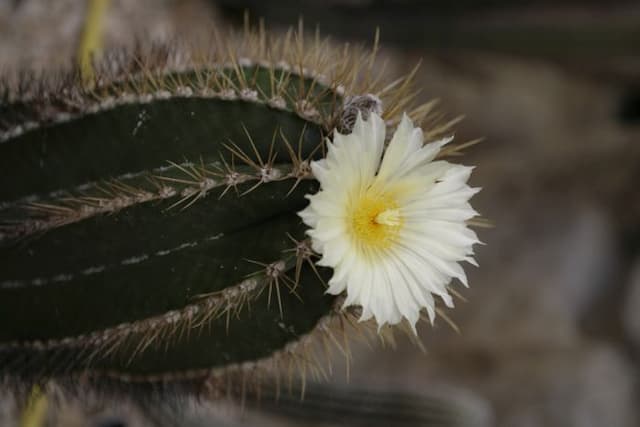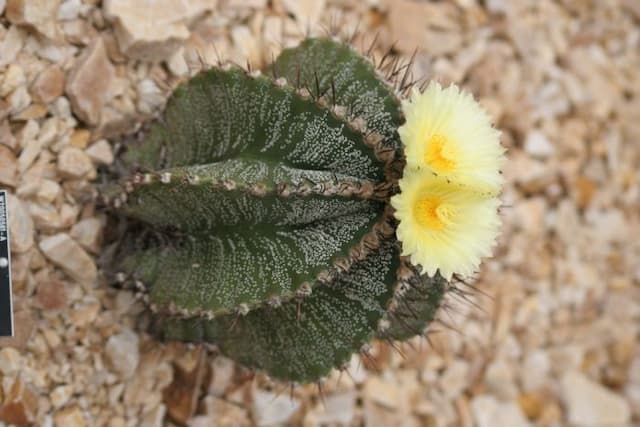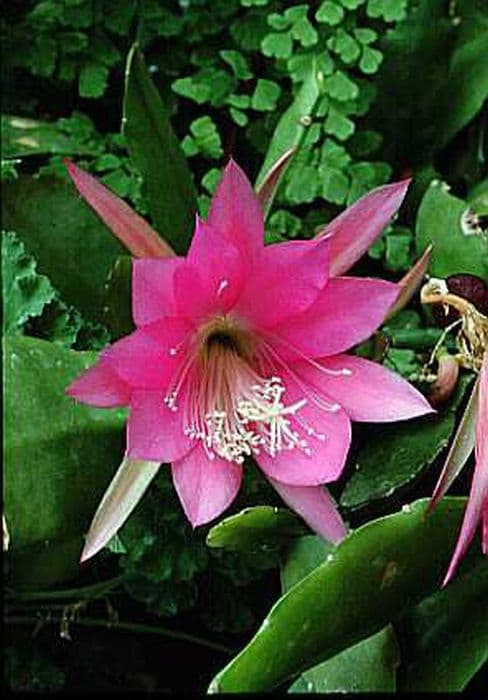Isla Carmen pincushion cactus Mammillaria carmenae

ABOUT
M. carmenae is a clustering cactus with globose stems to 8cm in height, the areoles with about 100 cream radial spines; white or pink-tinged flowers 1cm in length are borne towards the apex of each stem in spring and summer
About this plant
 Names
NamesFamily
Cactaceae
Synonyms
Carmen Pincushion Cactus, Snowball Cactus
Common names
Mammillaria carmenae
 Characteristics
CharacteristicsLife cycle
Perennials
Foliage type
Evergreen
Color of leaves
Varies
Flower color
Pink
Height
4 inches [10 cm]
Spread
6 inches [15 cm]
Plant type
Cactus
Hardiness zones
9
Native area
Mexico
Benefits
 General Benefits
General Benefits- Low Maintenance: Mammillaria carmenae, commonly known as 'Carmen Pincushion', requires minimal care and is great for beginner gardeners.
- Drought Tolerant: This cactus is well-adapted to survive in dry conditions, making it suitable for xeriscaping.
- Aesthetic Appeal: The Carmen Pincushion produces attractive pink flowers that can enhance the visual appeal of any collection or garden.
- Small Size: Its compact size makes it perfect for small spaces and indoor cultivation.
- Ornamental: The symmetric growth and pattern of spines offer ornamental value for rock gardens and terrariums.
- Habitat Conservation: Cultivating Mammillaria carmenae can contribute to the conservation of the species, as it is native to a specific region in Mexico.
 Medical Properties
Medical PropertiesThis plant is not used for medical purposes.
 Air-purifying Qualities
Air-purifying QualitiesThis plant is not specifically known for air purifying qualities.
 Other Uses
Other Uses- Mammillaria carmenae, commonly known as Carmen Pincushion Cactus, is often used in miniature fairy gardens due to its small size and decorative appeal.
- Its resilience and ability to thrive with minimal attention make Carmen Pincushion Cactus an ideal choice for educational projects on desert flora and plant survival strategies.
- This plant is sometimes used as a living gift or souvenir, symbolizing protection and endurance, due to its spiny exterior.
- Carmen Pincushion Cactus can be incorporated into landscaping projects that focus on xeriscaping, reducing the need for irrigation.
- Due to its spherical shape and patterned spines, it is used in photography and art for studies of natural symmetry and texture.
- Hobbyists often use Carmen Pincushion Cactus for grafting experiments to create unique cactus varieties with it as the rootstock.
- In the fashion industry, the distinctive look of Carmen Pincushion Cactus has inspired textile patterns and jewelry designs.
- The slow growth rate of this cactus makes it a symbol of patience and is used as a thematic element in mindfulness and meditation spaces.
- As a small and hardy plant, the Carmen Pincushion Cactus serves as a desk plant, providing a low-maintenance touch of nature in office environments.
- Collectors of rare and unusual plants often include Carmen Pincushion Cactus in their collections for its aesthetic appeal and rarity in certain regions.
Interesting Facts
 Feng Shui
Feng ShuiThe Mammillaria carmenae, commonly known as the 'Pincushion cactus', is not used in Feng Shui practice.
 Zodiac Sign Compitability
Zodiac Sign CompitabilityThe Pincushion cactus is not used in astrology practice.
 Plant Symbolism
Plant Symbolism- Resilience: Mammillaria carmenae, also known as the Carmen Pincushion Cactus, lives in arid environments, symbolizing the ability to thrive and persist through harsh conditions.
- Protection: Its spines offer protection from herbivores, denoting a defense against adversity and harm.
- Independence: As a cactus, it requires minimal water and care, embodying self-sufficiency and autonomy.
- Adaptation: Its ability to adapt to extreme conditions makes it a symbol of flexibility and the capacity to adjust to changing environments.
- Beauty and Tenacity: Despite its rugged exterior, the Carmen Pincushion Cactus produces beautiful flowers, representing the idea that beauty can flourish even in tough situations.
 Water
WaterFor a Mammillaria carmenae, commonly known as Carmen Pincushion Cactus, watering should be minimal, as this species is drought-tolerant. During the growing season in spring and summer, water it once every week or two, allowing the soil to dry out completely between waterings. Provide roughly 2-4 ounces of water per session, depending on the size of the plant and pot. In fall and winter, reduce watering to once every three to four weeks, to mimic the plant's natural dormant period.
 Light
LightCarmen Pincushion Cactus thrives best in bright, indirect light. It can tolerate some direct sunlight, but too much can burn the plant. A spot near an east or south-facing window where it can receive plenty of light without the harsh midday sun is ideal for this cactus.
 Temperature
TemperatureThe Carmen Pincushion Cactus prefers temperatures ranging between 70°F and 80°F during the day and should not be exposed to temperatures below 50°F to prevent cold damage. Ideally, keep it in an environment with nighttime temperatures dropping no more than 10-15 degrees from the daytime temperature.
 Pruning
PruningPruning the Carmen Pincushion Cactus is generally not necessary as it maintains its shape naturally. If there are any damaged or dead spines or flowers, they can be gently removed to promote healthy growth. The best time to check for any pruning needs is during its active growing season in the spring and summer.
 Cleaning
CleaningAs needed
 Soil
SoilThe best soil mix for Carmine Pincushion Cactus (Mammillaria carmenae) should be well-draining with a pH around 5.5 to 7. A mixture of 50% mineral grit, such as coarse sand, pumice, or perlite, with 50% potting soil or cactus mix works well. Ensure the soil allows for quick water drainage to prevent root rot.
 Repotting
RepottingThe Carmine Pincushion Cactus should generally be repotted every two to three years or when it has outgrown its current pot. It's best repotted during the spring season, which provides time for the plant to acclimate and establish in the warmer months.
 Humidity & Misting
Humidity & MistingCarmine Pincushion Cactus thrives in low to moderate humidity levels. While it can tolerate some humidity, typical indoor levels are usually sufficient. There's no need for high humidity environments, and excessive humidity can promote fungal diseases.
 Suitable locations
Suitable locationsIndoor
Place in a sunny spot, water sparingly, and allow soil to dry.
Outdoor
Full to partial sun, shelter from heavy rain, well-draining soil.
Hardiness zone
9-11 USDA
 Life cycle
Life cycleMammillaria carmenae, commonly known as Carmen Pincushion Cactus, begins its life when a seed germinates in well-draining soil under bright, indirect light. The seedling stage is followed by a juvenile period, during which the cactus develops its globular shape with tubercles and begins to produce spines. As it matures, the plant starts to flower annually, typically in the spring, if provided with the right environmental conditions, such as cooler winter temperatures to promote blooming. After flowering, the cactus may produce small, edible fruits containing seeds that can disperse to give rise to new plants. Throughout its life, which can span several decades, the cactus grows slowly, often producing offsets or 'pups' that form a clump around the parent plant. These offsets can be divided and repotted to propagate the cactus, continuing the life cycle.
 Propogation
PropogationPropogation time
Spring to summer
Propogation: The most popular method of propagating the Mammillaria carmenae, commonly known as the Carmen Pincushion Cactus, is through seeds. The best time to sow the seeds is during the warm season when temperatures generally range from 70 to 100 degrees Fahrenheit (21 to 37 degrees Celsius). Sow the seeds on the surface of a well-draining soil mix, ideally composed of a blend of potting soil and sand or perlite to ensure proper drainage. After scattering the seeds, they should be covered with a thin layer of sand or fine gravel, and the soil should be kept moist until germination, which usually occurs within a few weeks to several months depending on temperature and conditions. Once seedlings have established, they can be carefully transplanted into their own pots to continue growing.









